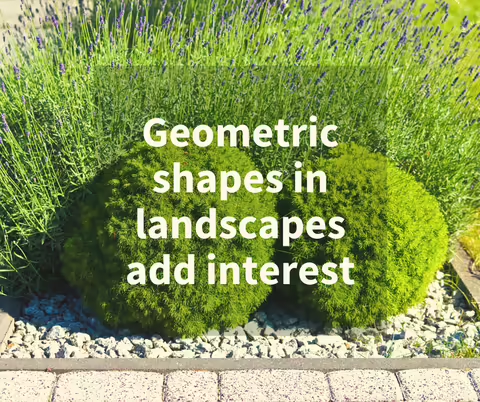Plants come in a variety of shapes. Taking advantage of those geometric forms can create interest in your landscape. The following examples will help enliven the design of your outdoor space.
Pyramid. Think of spruce trees and many other conifers. They are broad at the base, tapering to a point at the top, drawing the eye. They have the added benefit of being symmetrical from all views. Used sparingly, they draw attention as a showpiece but too many ruins their punch.
Horizontal. Ground covers are horizontal, growing wider than they are tall. They give the impression of stability, anchoring the rest of your plants to the earth. You can use horizontal plants to camouflage the bare stems of plants growing behind them. My favorite horizontals are Iberis (candytuft) and carpet Juniper.
Round. Looking for some unobtrusive plants to set off a stunner next to it? Go for plants with a rounded habit. They appear softer, enhancing the plant you want to showcase. Being the most common shape, there are many from which to choose. A few examples are asters, mums, some monardas (bee balm), and many of the smaller ornamental grasses like Sporobolus.
Column. These are eye-catchers much like pyramidal plants but are softer so they can be grouped to form a natural hedge or privacy wall. Their upright, narrow habit works well in crowded spots where a small footprint is an advantage. Try columnar arborvitae or feather reed grass (Calamagrostis x acutiflora) in those cramped places or where you want a green wall.
Vase. Vase-shaped plants are narrow at the bottom, spreading out wider at the top where the flowers usually are. Use them in areas where there isn’t much space on the ground, but there is room up higher above smaller plants. A few examples are Joe-Pye weed, zinnias, and cleome.
Weeping. If you are looking for something elegant and graceful choose a weeping tree. The eye follows the branches down to the ground where other plants dwell. The movement of the branches in the wind is calming. The density of the branches can hide something higher up that you don’t want to be noticed. Because of their drama, one weeping plant is all you need. Weeping cherry or a Wisteria with its long draping flowers both work well.
Next time you bring home a new addition to your yard, consider its shape when deciding the ideal place to plant it.
The Edgar County Master Gardeners of Illinois Extension enjoy teaching others about horticulture. If you have questions, please call 217-465-8585.
SOURCE: Jan Phipps, Master Gardener, Edgar County
ABOUT EXTENSION: Illinois Extension leads public outreach for University of Illinois by translating research into action plans that allow Illinois families, businesses, and community leaders to solve problems, make informed decisions, and adapt to changes and opportunities.
